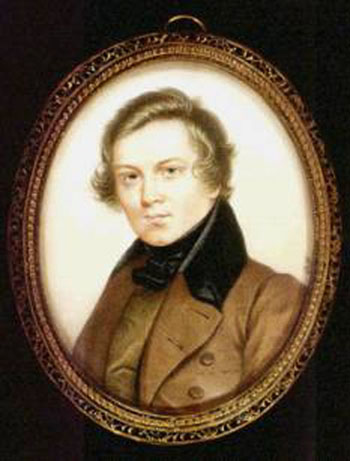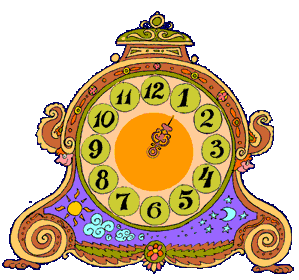"The history of music, supported by the actual hearing of
the master compositions of the different epochs, is the
shortest way to cure you of self-esteem and vanity."
AUTHOR: Robert Schumann
MEANING OF THE QUOTE:
"A person may think their art is great until
they compare it with the greatest masters
such as Beethoven and Mozart."
MEANING OF THE QUOTE:
"A person may think their art is great until
they compare it with the greatest masters
such as Beethoven and Mozart."
SYMPHONY NO. 101
in D MAJOR HOB. I:101
"The Clock" (1793-94)
Complete
"The Clock" (1793-94)
Complete
Charles Mackerras, Conductor
Orchestra of St. Luke's
Orchestra of St. Luke's
00:00 - Adagio - Presto
SYMPHONY NO. 101
in D MAJOR HOB. I:101
"The Clock" (1793-94)
I. Adagio - Presto
Mogens Woldike, Conductor
Vienna State Opera Orchestra
In the "Clock," the first movement's
chromatically edgy slow D-minor
mode introduction is mysterious;
dark and hushed, but the suspense
quickly shifts to a change of key; a
light-footed presto principle theme
in six-eight time.
The secondary theme proves
to be more a variant than a
contrast; the development is
a surprisingly contrapuntal.
SYMPHONY NO. 101
in D MAJOR HOB. I:101
"The Clock" (1793-94)
II. Andante
Ferenc Fricsay, Conductor
RIAS Symphony Orchestra Berlin

It is the Andante (second movement)
that gives the Symphony its nickname.
The music begins with the famous
evocation of a ticking grandfather
clock created by pizzicato (plucked)
lower strings and a metronomic
staccato ostinato in the bassoons.
This is accompanied by a simple, but
charming, stately melody; a stormy
ferocious G-minor interlude in the
middle of the movement followed by
some harmonic jokes and finally
resolved by the "clock’s" return in
a quiet and courtly stability. Hearing
the sounds of the clocks the listener
can imagine a variety of different
types of clocks "ticking."
.jpg) |
|
WHICH MAY HELP TO REMEMBER THE TUNE
(IN A DIFFERENT KEY THEN THE ORIGINAL
TO MAKE IT MORE VOICE FRIENDLY)
|

ORCHESTRAL COLOR GRAPH
OF MOVEMENT II
(Click to see enlarged)
 |
| http://www.orchestralrevolution.com/orchestral-graphs.php# |



SYMPHONY NO. 101
in D MAJOR HOB. I:101
"The Clock" (1793-94)
III. Menuet: Allegretto
Ferenc Fricsay, Conductor
RIAS Symphony Orchestra Berlin
The Minuet, with its use of
trumpets and drums, is lavish
with elaborate scoring and
contrapuntal effects; the
longest one Haydn wrote for
any of his symphonies. It has
a contrasting Trio section
emulating the sound of a
rustic band. This section is
gently pleasant but also slightly
comical as the music flow is
sometimes interrupted by what
sounds like some not-very-
talented village band musicians,
playing deliberate "wrong"
notes emphasized with
occassional musical outbursts.
SYMPHONY NO. 101
in D MAJOR HOB. I:101
"The Clock" (1793-94)
IV. Vivace
Herbert von Karajan, Conductor
Berliner Philharmoniker
The finale, brilliant and
energetic Vivace, is an
extremely elaborate
sonata rondo which
is built from a few
remarkably simple
melodic ideas that
continue to evolve and
develop in a fugal format
throughout the movement.
 |
| Salvador Dali: Melting Clocks |
TO LISTEN TO A HISTORY AND ANALYSIS OF
THIS SYMPHONY CLICK ON THE LINK BELOW
http://www.bbc.co.uk/programmes/p01y2tmk
LINKS
THIS SYMPHONY CLICK ON THE LINK BELOW
http://www.bbc.co.uk/programmes/p01y2tmk
GRANADA ADV. STRINGS
1. A MAJOR SCALE: 2 8VAS
2. ELEANORE RIGBY
INTRO. TO INSTRUMENTS
GRANADA
1. RECORDERS
a. First Sounds (Ugly vs Good)b. Discussed squeaking and how to stop it
c. Started songs with i finger down
HILLVIEW
1. RECORDERS
a. TURKEY TROT (1,2,3 by number)b. Whacky Nutcracker (1,2,3 by number)
1) Started to explain musical road signs (to be continued)
GRANADA BEG. STRINGS
1. SHIFTING THE SCALE
a. Pattern 0-1-1-1-... on each string up
2. HO HEY
a. Whole note/half note section
HILLVIEW ORCHESTRA
1. ELEANORE RIGBY
1. ELEANORE RIGBY








.jpg)
.jpg)

.jpg)
trio.jpg)

.jpg)
.jpg)

